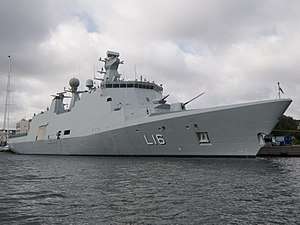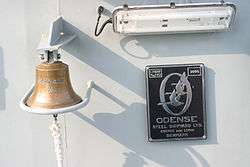Absalon-class support ship
The Absalon class are support ships of the Royal Danish Navy,[2][3][4] commissioned in 2005. The two ships in the class may be described as a hybrid between a frigate and military transport ship with multiple role capabilities,[5] with the capacity to be transformed from a combat ship with the firepower of a traditional frigate to a hospital ship within a day.[6]
 HDMS Absalon (L16) | |
| Class overview | |
|---|---|
| Builders: | Odense Staalskibsværft |
| Operators: | Royal Danish Navy |
| Preceded by: | Falster-class minelayers |
| Cost: | DKK2.5bn (total),[1] (~US$225m/ship) excluding weapon modules |
| Built: | 2003–2004 |
| In commission: | 2005–present |
| Completed: | 2 |
| Active: | 2 |
| General characteristics | |
| Type: | support ships |
| Displacement: | |
| Length: | 137 m (449 ft 6 in)[1] |
| Beam: | 19.5 m (64 ft 0 in)[1] |
| Draft: | 6.3 m (20 ft 8 in)[1] |
| Propulsion: | |
| Speed: | 24 knots (44 km/h)[1] |
| Range: | 9,000 nmi (17,000 km) at 15 kn (28 km/h)[1] |
| Boats & landing craft carried: | 2 × RHIBs, 2 × SB90E LCP |
| Complement: | 100, plus aircrew and transients (accommodation for up to 300 in total) |
| Sensors and processing systems: | |
| Electronic warfare & decoys: |
|
| Armament: |
|
| Aircraft carried: |
2 × EH-101 helicopters[1] or 2 MH-60R helicopters |
| Aviation facilities: | Aft helicopter deck and hangars |
Design
The class is based on a frigate-like design, but built with an internal multipurpose deck (flex deck) and a stern vehicle ramp. The ships can serve as command platforms for a staff of 75 persons (naval or joint staff) with a containerized command and control centre, transport and base of operations for a company-sized landing force of some 200 men with vehicles. Alternatively, the flex deck can be used for mine-laying operations with a capacity of some 300 mines, or be fitted out for mine-clearing operations and launch and recover mine detecting and clearing equipment via a retractable gantry crane, adjacent to the stern vehicle ramp, which also is used for launching and recovering the fast landing craft. Furthermore, the flex deck can support a containerized hospital or simply transport a number of ISO standard containers or some 55 vehicles, including up to seven MBTs. The ships can carry two LCPs (Storebro SB90E), two rigid hull inflatable boats and two EH101 helicopters.
The ships have been designed by a joint team from The Royal Danish Navy (RDN), the Danish Defence Acquisition and Logistics Organization (DALO) and a group of contractors, primarily Odense Maritime Technology (OMT) to the Royal Danish Navy's requirements for a multi-mission frigate-like ship with an emphasis on flexibility.
The ships are built to the naval standards of Det Norske Veritas (DNV GL), an international certification body and classification society, heavily utilizing STANAG.
The design is built with the aim of a large margin for growth over life-cycle, to a relatively low cost of ownership, with open architecture for ease of upgrades, with a high degree of automation allowing smaller crews, and utilizing StanFlex modules that can be shared across several ship classes in service with the Royal Danish Navy.
The hulls were built in highly competitive commercial shipyards using the latest development in the industries shipbuilding technology and cost-effective production procedures and processes. The outfitting and integration of sensor, communication and weapons systems was primarily carried out "in-house" by the RDN and DALO.
The standard weapons of the Absalon class can be supplemented through the use of StanFlex mission modules.[7] A special weapons deck (nicknamed the 'Bathtub') is designed with five StanFlex module slots.[7] Because of the Bathtub's position, only missile-firing weapons modules can be installed.[7]
In 2014 Jim Dorschner proposed that Canada replace its Iroquois-class destroyers with modified Absalon-class vessels.[8] The main modification would be lengthening the vessels' hulls so the engine room could accommodate four engines, instead of the two engines Danish Absalons have.
History
The ships were named after two brothers, Esbern Snare and archbishop Absalon, who led the naval campaigns in the 12th century against the Wends, a group of pagan Slavs in northern Germany.
Production started at Odense Steel Shipyard on 30 April 2003,[1] with the lead ship Absalon laid down on 28 November of that year.[1] Esbern Snare followed on 24 March 2004; they were both launched later that year.[1] They were delivered on 19 October 2004 and 17 April 2005 respectively, and commissioned on 10 January 2005 and 17 June 2005.[1] At this point they had the StanFlex modules installed, but would have to wait until 2007 for full operational capability,[1] with the installation of the 35mm CIWS, Mk32 torpedo launchers and Seagnat/SRBOC decoy systems.
List of ships
| Name | Number | Launched | Commissioned | Status |
|---|---|---|---|---|
| Absalon | L16 | 25 February 2004 | 19 October 2004 | Active |
| Esbern Snare | L17 | 21 June 2004 | 18 April 2005 | Active |
References
- "Fleksible Støtteskibe" (pdf) (in Danish). Danish Defence. Retrieved 2013-06-15.
- Royal Danish Navy: Support Ships, ABSALON-class Archived June 7, 2011, at the Wayback Machine
- "An Overview of Current, On-Going Danish Naval projects -- 2005-2009 Absalon class Command and Support Ship (CSS / Transport Frigate)". Canadian American Strategic Review. May 2008. Archived from the original on 24 June 2009. Retrieved 2009-07-12.
- "An Overview of Current, On-Going Danish Naval projects 2005-2009 Projekt Patruljeskib – a Patrol Ship or Heavily-Armed Future Frigate". Canadian American Strategic Review. July 2008. Archived from the original on 15 June 2009. Retrieved 2009-07-12.
- "HDMS Absalon and HDMS Esbern Snare - Royal Danish Navy". Navy Recognition. Retrieved 12 December 2016.
- Pike, John. "Absalon Class Flexible Support Ship / Command Support Ship". globalsecurity.org. Retrieved 12 December 2016.
- Lok, Joris Janssen (24 April 2006). "New Danish combat support ships offer greater flexibility for NATO operations". International Defence Review. Jane's Information Group.
- Jim Dorschner (March 2014). "Over The Horizon – Next Generation Multi-role Absalon Destroyers: A Modest Proposal". Canadian American Strategic Review. Archived from the original on 2014-03-14.

External links

- Danish Naval History
- Admiral Danish Fleet Headquarters
- Danish Defence Acquisition and Logistics Organization
- HDMS Absalon Command and Support Ship - Flexible Support Ship
- Naval Technology